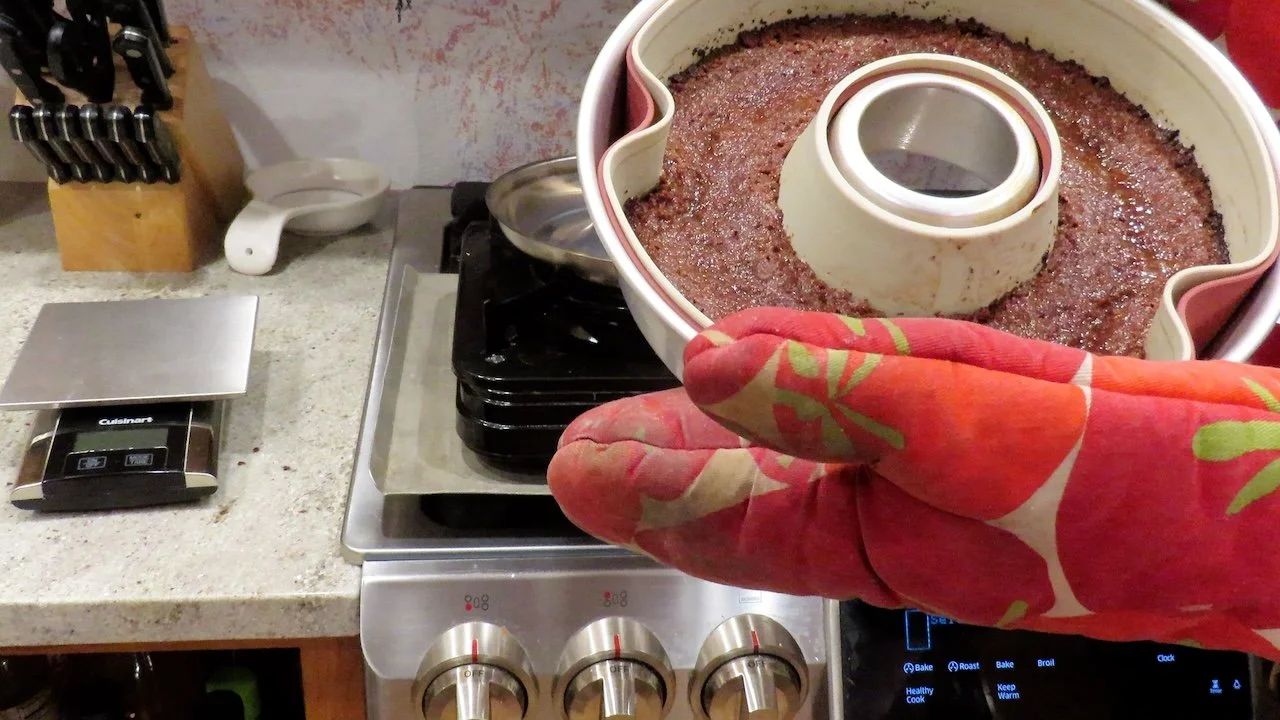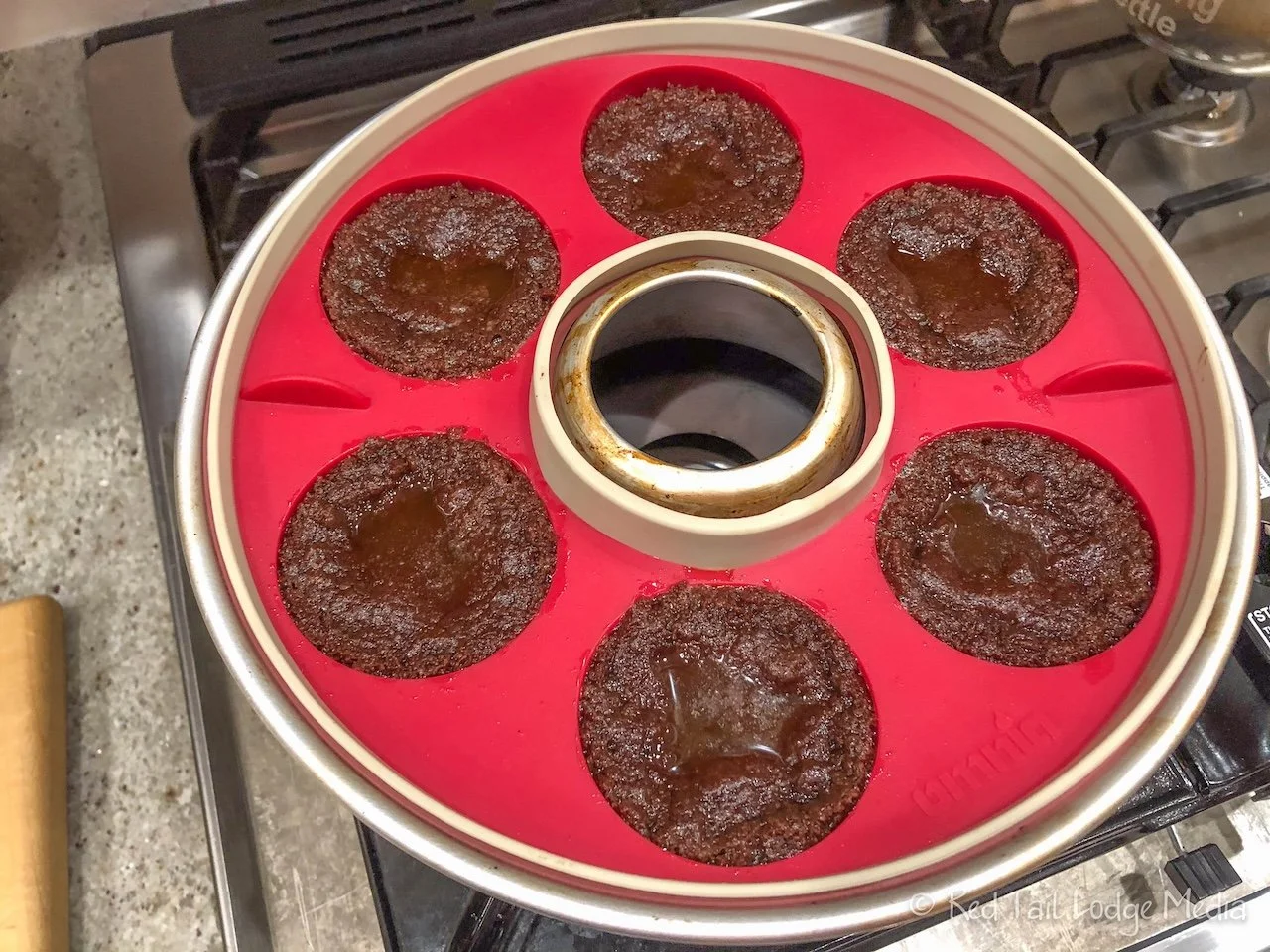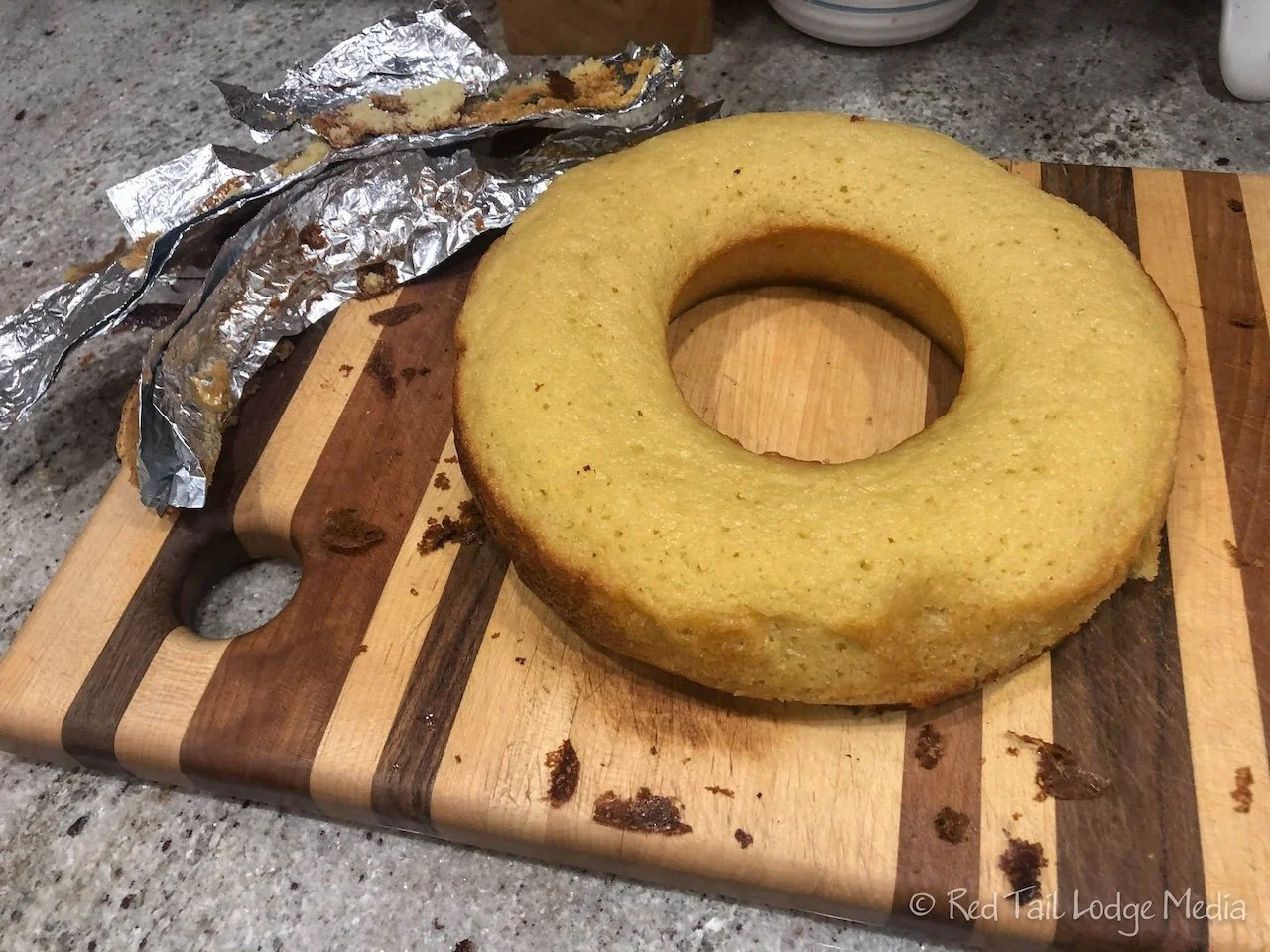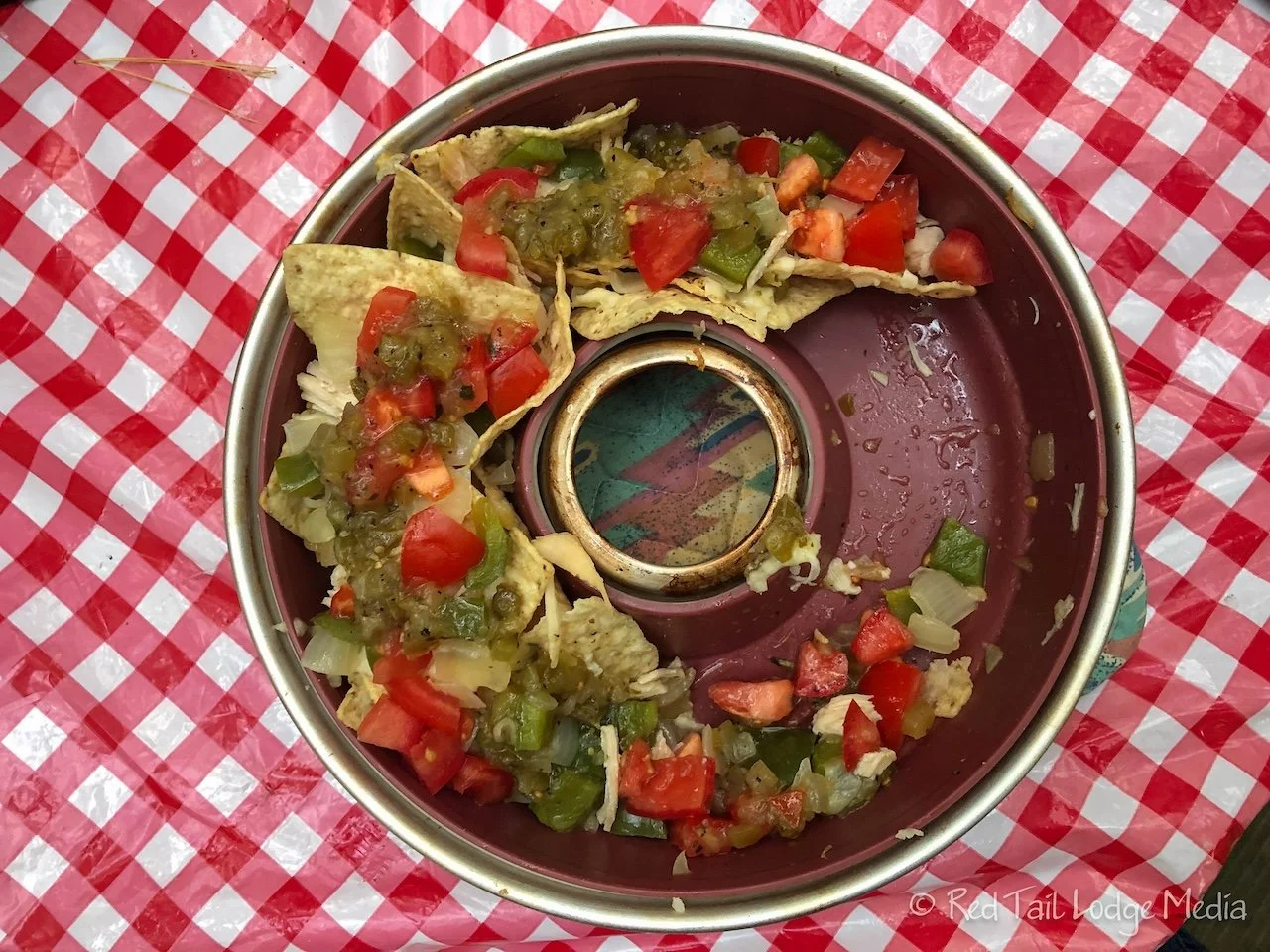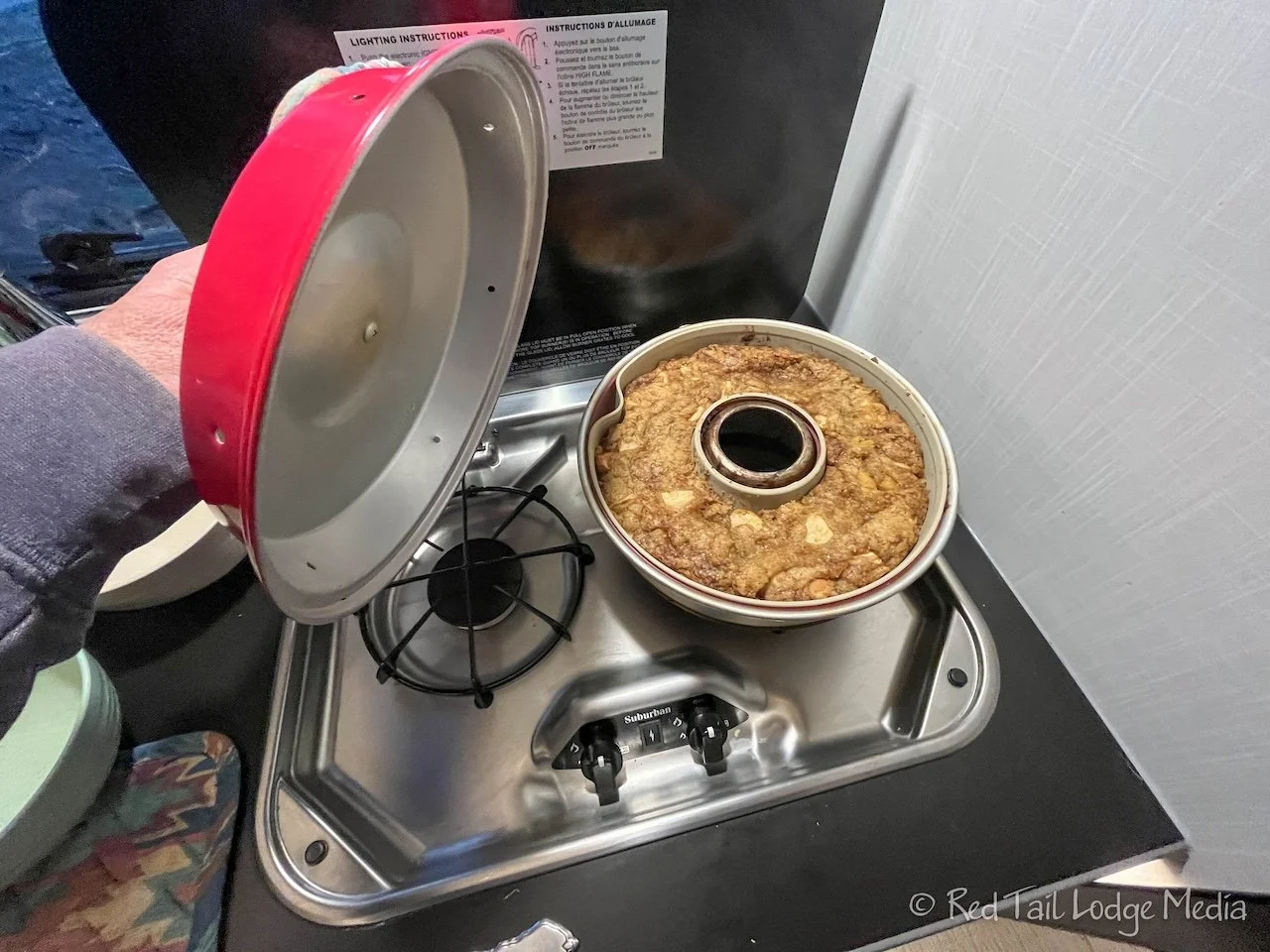Omnia Oven Review
Many RV’s and camper vans do not have ovens. Does that mean you cannot bake while traveling? There is an alternative. It is called an Omnia Oven which allows you to bake on a stove top. We bought one a few years ago and have been experimenting a little with it. Here are our thoughts on how well it works.
The Omnia Oven (paid link) is made by a company in Sweden. The basic oven has three parts, a stainless steel base, an aluminum pan shaped like a bundt pan, and an aluminum lid. The base shields the pan from direct heat and the hole in the middle allows heat to rise up and be reflected by the lid back down into the pan. So the food in the pan is heated from above and below. Keep in mind that the oven only works with some type of gas stove. It will not work with an electric or induction cooktop.
When we purchased the Omnia Oven, we also purchased most of the available accessories with it. The accessories included two silicon liners (paid link), a muffin ring (paid link), an oven rack (paid link), a cookbook, and a carrying bag. The silicon liners keep food from sticking to the pan and help shield the bottom of the food from too much heat. The oven rack is for baking items like frozen rolls, to allow air flow under the food.
What we didn’t know ahead of time was that the Omnia Oven comes in a drawstring bag, so the carrying bag was unnecessary. But we do like the carrying bag better than the drawstring bag.
The recipes in the cookbook didn’t sound very appealing to us, so we didn’t use any of them. For most of the items that we baked, we either took a normal recipe, meant for a 13 inch by 9 inch pan or regular bundt pan, and cut the amounts in half, or we used frozen prepared baked goods, such as cinnamon rolls or yeast rolls.
At first, we experimented using it on our butane camp stove (paid link) inside our house before we hit the road. We had some questions, like how hot does it get inside the Omnia Oven and how much fuel does it need to bake a recipe? More importantly, how well does it bake?
We had a little trouble accurately measuring the air temperature inside the oven, as we stuck some oven thermometer probes into the small holes on the lid but the probes are designed to be stuck into food, not measure the air temperature. However, we believe, at the minimum flame setting on our butane stove, the air temperature held somewhat steady near 350 degrees Fahrenheit, a good baking temperature. At a higher flame, the air temperature seemed to keep rising, but the food started to burn. This was when we were baking inside our house at room temperature, not outside in colder temperatures.
For most of the items that we tried to bake, the bake times were about the same as for baking in a regular oven. Again, this was when baking using our butane camping stove inside our house at room temperature (with proper ventilation). We compared the butane usage with other items that we would normally cook on our butane stove while traveling. Since most recipes had baking times around 30 minutes, that was on the longer side of other types of things we would cook. However, it was in the same range as cooking pasta.
As a side note, we learned that starting out with the pasta in the water instead of waiting until the water comes to a boil cut the total cooking time of pasta along with the amount of butane needed by almost 25%. Some would argue it affects the taste and texture of the pasta, but we didn’t notice much of a difference. So that is how we have been cooking our pasta since then.
We did run into an issue with the long baking times. Our butane stove would start to overheat after about 30 to 35 minutes and would automatically shut off, to prevent the butane cartridge from exploding. Some items may not be quite done by then and you would be left with something you could not finish baking. For some sweets, they may be still edible and tasty, albeit not ideal.
The items we tried to bake during our experiment were brownies, Swedish apple pie, chocolate soufflé cake, quiche, pound cake, nachos, take & bake torta rolls, frozen cinnamon rolls, frozen wheat dinner rolls, and apple brownies. The results were rather mixed.
The item that we thought would be the easiest to bake turned out to be the hardest. That was brownies. We were using a Baker’s chocolate recipe, which we’ve used so many times before in a regular oven. The issue was keeping the edges from burning while getting the center cooked enough. The Omnia Oven does not cook very evenly. The bottom, outside edges seems to cook the fastest, while the center of the food cooks much more slowly. We made five separate attempts to bake the brownies. We even tried shielding the edges of the brownies with aluminum foil. The most successful was to use the muffin mold along with one of the silicone liners, baking for 20 minutes and letting it coast for ten minutes in the pan with the heat off. The edges were not burnt, but the center still was not quite done. Still tasty, though.
The chocolate soufflé cake turned out better. They baked in the muffin mold along with both the silicone liners for 15 minutes, then coasted for five minutes.
The quiche and pound cake also turned out pretty well, both taking about 30 minutes to bake with a five minute coast using both silicone liners. We shielded the edges of the pound cake with aluminum foil. The pound cake did not stick to the silicone, but stuck to the foil.
The torta rolls were a little too large for the oven. They overhung the center hole and burned, both with and without the oven rack. After four minutes, the part overhanging the hole started to burn. We turned the rolls and baked for another three minutes, letting it coast for five minutes. They did get crispy on the outside and hot in the middle, but we did not care for them.
For the nachos, we used two liners and the oven rack, stacking tortilla chips, shredded cheddar cheese, along with sautéed onions and bell peppers. Baking for seven minutes and coasting for five did melt the cheese. However, we don’t think the oven rack was needed, it was just hard to clean afterwards.
The cinnamon rolls came out well once we figured out how many to bake at a time. When we only baked four of them for 15 minutes, coasting for five, they didn’t overhang the center hole and did not burn.
The frozen wheat rolls turned out OK, taking about seven to eight minutes to bake, coasting for five.
Our favorite item to bake was apple brownies. This is a recipe we got from a friend over thirty years ago. No chocolate is involved. It is chopped apples, flour, baking powder, baking soda, sugar, an egg, vanilla, cinnamon, and a pinch of salt. It takes a little longer to bake, about 30 minutes with ten minutes of coasting. Delicious.
We took the Omnia Oven on the road with us for Seasons Three, Four, and Five. However, about the only thing we ever baked in it on the road was the apple brownies. We don’t eat many sweets, especially in the summer. And when we do, we generally like to stop at a local bakery or coffee shop to try something new and different. We also had a microwave during Seasons Four and Five, so making nachos is much easier in a microwave than in the Omnia Oven. A quiche takes a long time to bake while an egg scramble takes a lot less time and fuel to make. Some recipes, like the chocolate soufflé cake and pound cake with vanilla cream sauce, are rather time-consuming to make, so we are more inclined to make those at home in the winter than on the road.
We also found that baking with the Omnia Oven outside in different temperatures added more variables that made it harder to use. Colder air temperatures accentuated the uneven cooking inside the oven. It also made it harder to determine baking times. The wind also added to the uneven cooking as it cooled down the outside of the oven and diverted the heat from the flickering flame. Unfortunately, when do you want to bake? When it’s cold outside! We see that Omnia now has a thermometer accessory which would help when dealing with all the variables.
During Season Three, before we had a microwave, we attempted chicken nachos in the Omnia Oven, but it was an epic fail. We left out the oven rack and loaded the tortilla chips with canned chicken in addition to the grated cheese and sautéed peppers and onions. After half an hour in the Omnia Oven with the flame on low, the cheese still had not melted.
We made a second attempt, outside of the Omnia Oven, by heating the cheese, peppers, onions, and chicken in a normal pot. The cheese melted fine and everything was warm in about ten minutes, but as soon as we removed it from the heat, it turned back into one solid blob. Not a very satisfying meal. (Lake Placid, New York - September 20th to 22nd, 2021)
The Omnia Oven was a little easier to use during Season Five. We then had a propane stove inside our rig, with a much better controlled environment regarding air temperature and wind. The propane stove didn’t seem to produce as much heat as our butane camping stove, so we needed to turn up the flame more on the propane stove when using the Omnia Oven.
So does the Omnia Oven work? Yes. Does it work as well as your oven at home. No. Is it worth it? You’ll have to decide. Others, such as YouTube channel creators From She to Me and We’re the Russos use the Omnia Oven more often than we do. Will we still carry it with us? Yes. Will we still use it to bake apple brownies? Yes, it’s a great way to use up apples that are starting to get old and we love the recipe. Will we expand our usage of the Omnia Oven to other recipes? Maybe, maybe not. Time will tell.
Check out our related video: Omnia Oven Review
(Ann)










